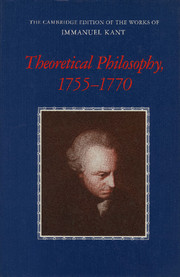Book contents
- Frontmatter
- Contents
- General editors' preface
- Preface
- Guide to abbreviations
- General introduction
- Introductions to the translations
- Résumés of the works
- A NEW ELUCIDATION OF THE FIRST PRINCIPLES OF METAPHYSICAL COGNITION (1755)
- THE EMPLOYMENT IN NATURAL PHILOSOPHY OF METAPHYSICS COMBINED WITH GEOMETRY, OF WHICH SAMPLE I CONTAINS THE PHYSICAL MONADOLOGY (1756)
- AN ATTEMPT AT SOME REFLECTIONS ON OPTIMISM (1759)
- THE FALSE SUBTLETY OF THE FOUR SYLLOGISTIC FIGURES (1762)
- §1 General concept of the nature of syllogisms
- §2 Concerning the supreme rules governing all syllogisms
- §3 Concerning pure and mixed syllogisms
- §4 In the so-called first figure only pure syllogisms are possible. In the remaining three figures nothing but mixed syllogisms is possible
- §5 The logical division of the four syllogistic figures is a piece of false subtlety
- §6 Concluding reflection
- THE ONLY POSSIBLE ARGUMENT IN SUPPORT OF A DEMONSTRATION OF THE EXISTENCE OF GOD (1763)
- ATTEMPT TO INTRODUCE THE CONCEPT OF NEGATIVE MAGNITUDES INTO PHILOSOPHY (1763)
- INQUIRY CONCERNING THE DISTINCTNESS OF THE PRINCIPLES OF NATURAL THEOLOGY AND MORALITY (1764)
- M. IMMANUEL KANT'S ANNOUNCEMENT OF THE PROGRAMME OF HIS LECTURES FOR THE WINTER SEMESTER 1765 — 1766 (1765)
- DREAMS OF A SPIRIT-SEER ELUCIDATED BY DREAMS OF METAPHYSICS (1766)
- CONCERNING THE ULTIMATE GROUND OF THE DIFFERENTIATION OF DIRECTIONS IN SPACE (1768)
- ON THE FORM AND PRINCIPLES OF THE SENSIBLE AND THE INTELLIGIBLE WORLD [INAUGURAL DISSERTATION] (1770)
- Factual notes
- Bibliographies of editions and translations
- Glossary
- Biographical-bibliographical sketches of persons mentioned by Kant
- Index
§5 - The logical division of the four syllogistic figures is a piece of false subtlety
Published online by Cambridge University Press: 18 December 2014
- Frontmatter
- Contents
- General editors' preface
- Preface
- Guide to abbreviations
- General introduction
- Introductions to the translations
- Résumés of the works
- A NEW ELUCIDATION OF THE FIRST PRINCIPLES OF METAPHYSICAL COGNITION (1755)
- THE EMPLOYMENT IN NATURAL PHILOSOPHY OF METAPHYSICS COMBINED WITH GEOMETRY, OF WHICH SAMPLE I CONTAINS THE PHYSICAL MONADOLOGY (1756)
- AN ATTEMPT AT SOME REFLECTIONS ON OPTIMISM (1759)
- THE FALSE SUBTLETY OF THE FOUR SYLLOGISTIC FIGURES (1762)
- §1 General concept of the nature of syllogisms
- §2 Concerning the supreme rules governing all syllogisms
- §3 Concerning pure and mixed syllogisms
- §4 In the so-called first figure only pure syllogisms are possible. In the remaining three figures nothing but mixed syllogisms is possible
- §5 The logical division of the four syllogistic figures is a piece of false subtlety
- §6 Concluding reflection
- THE ONLY POSSIBLE ARGUMENT IN SUPPORT OF A DEMONSTRATION OF THE EXISTENCE OF GOD (1763)
- ATTEMPT TO INTRODUCE THE CONCEPT OF NEGATIVE MAGNITUDES INTO PHILOSOPHY (1763)
- INQUIRY CONCERNING THE DISTINCTNESS OF THE PRINCIPLES OF NATURAL THEOLOGY AND MORALITY (1764)
- M. IMMANUEL KANT'S ANNOUNCEMENT OF THE PROGRAMME OF HIS LECTURES FOR THE WINTER SEMESTER 1765 — 1766 (1765)
- DREAMS OF A SPIRIT-SEER ELUCIDATED BY DREAMS OF METAPHYSICS (1766)
- CONCERNING THE ULTIMATE GROUND OF THE DIFFERENTIATION OF DIRECTIONS IN SPACE (1768)
- ON THE FORM AND PRINCIPLES OF THE SENSIBLE AND THE INTELLIGIBLE WORLD [INAUGURAL DISSERTATION] (1770)
- Factual notes
- Bibliographies of editions and translations
- Glossary
- Biographical-bibliographical sketches of persons mentioned by Kant
- Index
Summary
One cannot deny that valid inferences may be drawn in all these four figures. But it is indisputable that all four figures, with the exception of the first, determine the conclusion only indirectly by means of interpolated intermediate inferences. It is further indisputable that exactly the same conclusion can be inferred, in pure and undiluted form, from the same middle term employing the first figure. Now, it might at this point occur to someone to suppose that, if such were the case, then the three other figures would, at worst, be useless, but not actually false. But if one considers the intention which inspired their invention and continues to inspire their presentation, one will come to a different view of the matter. Suppose that one wished to bring about the following situation. A number of inferences and the main judgements, all intermingled together, are to be entangled with each other in such a fashion that, some being explicitly stated and others suppressed, a great deal of skill will be required to determine whether or not they conform to the laws of inference. If this were one's objective, one might invent, not, indeed, new figures, but new and puzzling inferences capable of causing headaches enough. The purpose of logic, however, is not to confuse but to clarify? its aim is not to obscure but clearly to reveal. Hence, these four modes of inference ought to be simple, unmixed and free from concealed supplementary inferences. If they do not satisfy these conditions they are not to be granted the freedom of appearing in a logical discourse as the formulae which represent the syllogism in clearest form. It is also certain that hitherto all logicians have regarded them as simple syllogisms, not requiring the interpolation of additional judgements. Had they not been regarded in this light, they would never have received their citizenship. Thus, the remaining three modes of inference, construed as syllogistic rules in general, are correct; but construed as containing a simple and pure inference, they are mistaken.
- Type
- Chapter
- Information
- Theoretical Philosophy, 1755–1770 , pp. 99 - 101Publisher: Cambridge University PressPrint publication year: 1992
- 1
- Cited by



